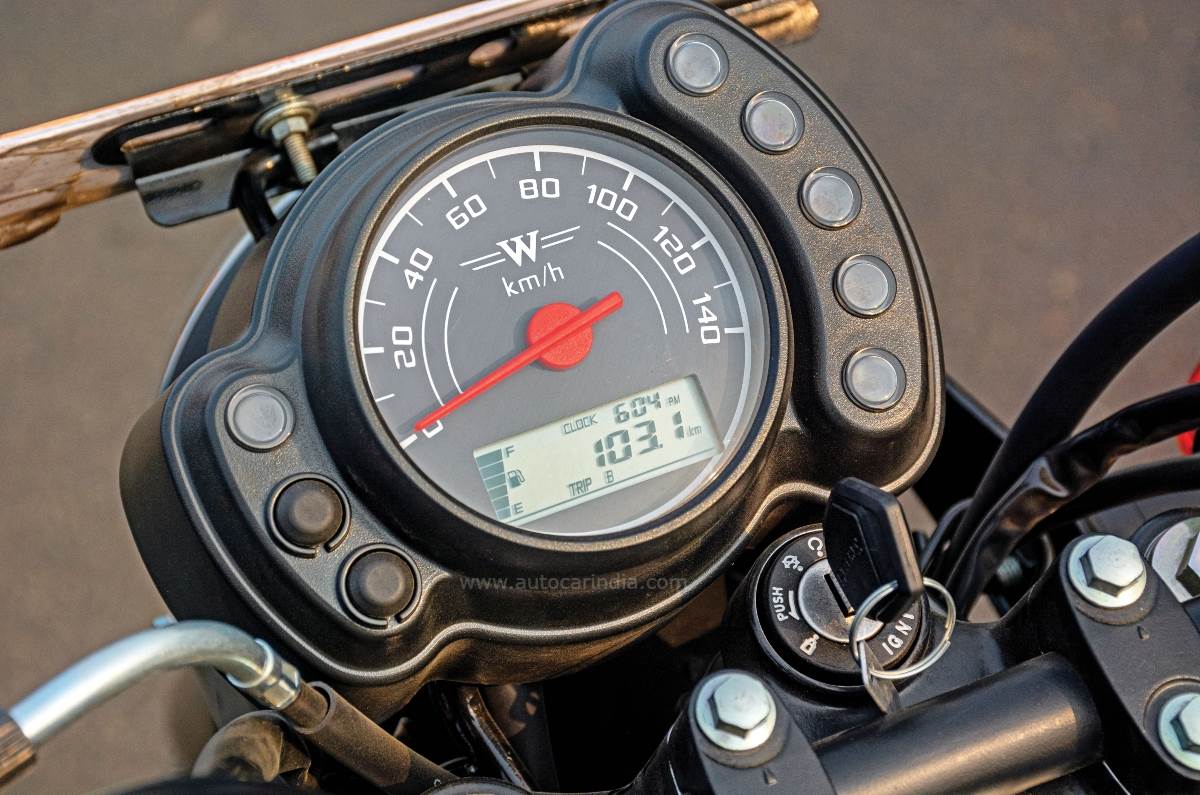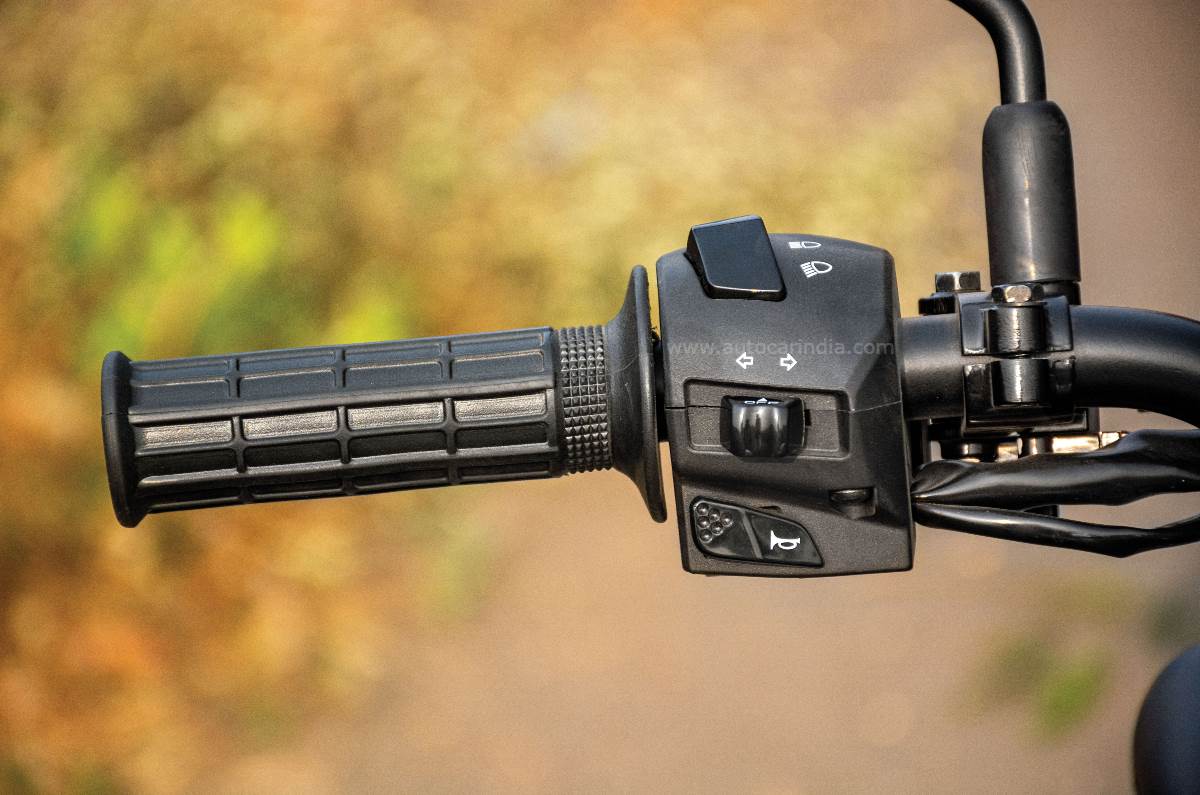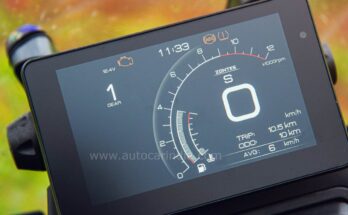Kawasaki’s new, retro motorcycle is the brand’s most affordable offering in India.
Of late, it seems like everything has been going retro. From fashion to music, there is a huge sense of nostalgia growing in our society. This has well and truly extended to motorcycles as well, with the latest case being the Kawasaki W175 – a motorcycle from the 2020s featuring a small-capacity air-cooled engine, a rear drum brake and a simple halogen headlamp. But fret not, there’s so much more to the W175 than what meets the eye. Read on to find out.
Kawasaki W175 review: design
The new W175 is the smaller sibling of Kawasaki’s W800 retro motorcycle. And while the W800 is lovely to ride and look at, its rather high asking price was, for sure, a reason that put off many potential customers. This is exactly what the W175 is meant to do, be a more pocket-friendly option with the same charming retro experience of the W800.

Cluster is simple yet elegant; not big on features though.
And to that end, the W175 nearly gets all of it right. The round, chrome-trimmed halogen headlight, teardrop-shaped fuel tank, boxy side panel, curved fenders and simple tail-light are all reminiscent of the classy W800. The only qualms are that it appears a bit too small and bare-bones, and in this black colour, it looks too simple as well. I’m sure the Candy Persimmon red paint option with its gold detailing would do this motorcycle more justice. Still, you can’t fault Kawasaki as there is a certain beauty in the W175’s simplicity.
Kawasaki W175 review: features
In keeping with the retro theme, the smaller W sibling gets a simple analogue instrument cluster with a small digital readout that displays the fuel level, odometer, trip meter and clock. The cluster has a nice old-school font with the W logo in the centre and it is flanked by warning lights as well as buttons to control the digital screen. The switchgear meanwhile, is nice to operate and of good quality too.

Switchgear, build quality are more than acceptable.
Now features is an area where the W175 falls short. It makes do with a single disc brake with single-channel ABS, a halogen headlamp and a single-pod cluster. While some may argue that it isn’t necessary for a retro motorcycle to have fancy features, and they are right to a large extent, you can’t help but think that Kawasaki could have thrown in a few more things, considering you have to shell out nearly Rs 2 lakh (on-road, Mumbai) for the W175. A rear disc brake, dual-channel ABS, tachometer and a USB port would all have been welcome additions at this price.
Kawasaki W175 review: seating comfort
Nevertheless, hop on to the W175’s approachable 790mm throne, and you’re seated in a very commuter-ish position. You’re sat nice and upright with an easy reach to the handlebar and the foot pegs are front-set, which makes the overall riding position comfortable. The seat though is narrow and the padding is shallow, so it can get uncomfortable after riding for a while, as you end up with pressure points. And given its compact dimensions, it can get cramped for taller riders.
Kawasaki W175 review: engine and underpinnings
Powering the W175 is a tiny 177cc, two-valve, single-cylinder, air-cooled engine that puts out a modest 13hp and 13.2Nm. Now, while those figures are considerably down on its competition, the Kawasaki makes up for its lack of grunt by being a featherweight. Tipping the scales at just 135kg, the W175 weighs a whole 40kg less than the Royal Enfield Hunter 350. And that really does reflect in its performance numbers. Despite having a 7hp and nearly 14Nm disadvantage to the Hunter, the W175 gets to 60kph from a standstill in 5.26sec, which is just shy of the RE’s 4.95sec.

Refined 177cc engine pulls well till about 80kph.
Even in terms of in-gear acceleration, the W175 does 20-50kph in 3.69sec and the Hunter in 3.39sec, while in the 30-70kph run, the Kawasaki is only about a second behind the Royal Enfield. It’s only after 80kph that the little Kawi’s 177cc engine runs out of steam, taking an additional 10sec to do 80-100kph. It’s as the old adage says: there’s no replacement for displacement (the W175’s engine is nearly half the size of the Hunter’s).
Unlike in foreign markets, where it still uses an old-school carburettor to feed fuel, in India, Kawasaki has given the W175 fuel injection in order to comply with the emission norms. The engine itself is a refined unit and has a nice fruity tone to it. It’s not a slow-revving thumper like your typical RE, but on the move, this engine has a very relaxed nature, which goes well with this motorcycle’s character. It isn’t exactly what you’d call fast, but it does have a strong mid-range. The engine is very tractable and pulls cleanly from low down in the rev range, despite the slightly tall gearing. Some buzziness creeps in at higher revs and it struggles to get into triple-digit speeds, which is expected of an engine this size, but it’s not a deal breaker.
In terms of fuel efficiency, the Kawasaki proved to be a light sipper in our tests, returning 48.2kpl on the highway and 43.76kpl in the city. And as you’d expect, these figures are considerably higher than the Hunter’s 39.84kpl and 30.61kpl on the highway and city, respectively.

Brakes have good stopping power; feature ABS.
The gearbox is good and slick enough for the most part, but there were a few occasions during our test where it would hesitate to shift up. Clutch operation is light, which makes it a breeze to operate in traffic. As for the brakes, they have more than ample stopping power, bringing the W to a halt from 60kph in 17.52m. Still, the presence of a drum brake at the rear is a little too old-school at this price point.
Kawasaki has also managed to strike a good balance between ride and handling on the W175. Underpinning it is a simple, tubular, semi-double-cradle frame that’s suspended by a telescopic fork and twin shock absorbers. The smaller W tips into corners effortlessly and is quite composed when doing so. Surprising, given that it runs on skinny Ceat tyres. The tyres themselves have ample grip and give good feedback to the rider. The ride is also well-judged for the most part, as it doesn’t feel too firm or too soft. While, at times, it tackled bumps with relative ease, certain ones did manage to catch it out. But, despite having only 64mm travel at the rear, it didn’t bottom out in our test. It’s worth keeping in mind though that I have a lightweight frame, much like the W175.
Kawasaki W175 review: verdict
The W175 is one of those motorcycles that you buy with your heart and not with your head. Yes, there are plenty of motorcycles out in the market that will offer you more performance and features for a similar price, but that would be missing the point. Priced between Rs 1.47 lakh-1.49 lakh, the W175 costs around Rs 13,000 more than another Japanese neo-retro motorcycle – the Yamaha FZ-X – while costing just Rs 1,000 less than the Retro variant of the Royal Enfield Hunter. The W175 will appeal to those who want a simple, easygoing and authentic retro motorcycle riding experience. You will have to make do without certain modernities and have to shell out a premium, but the experience certainly makes it worth it.
Source link


